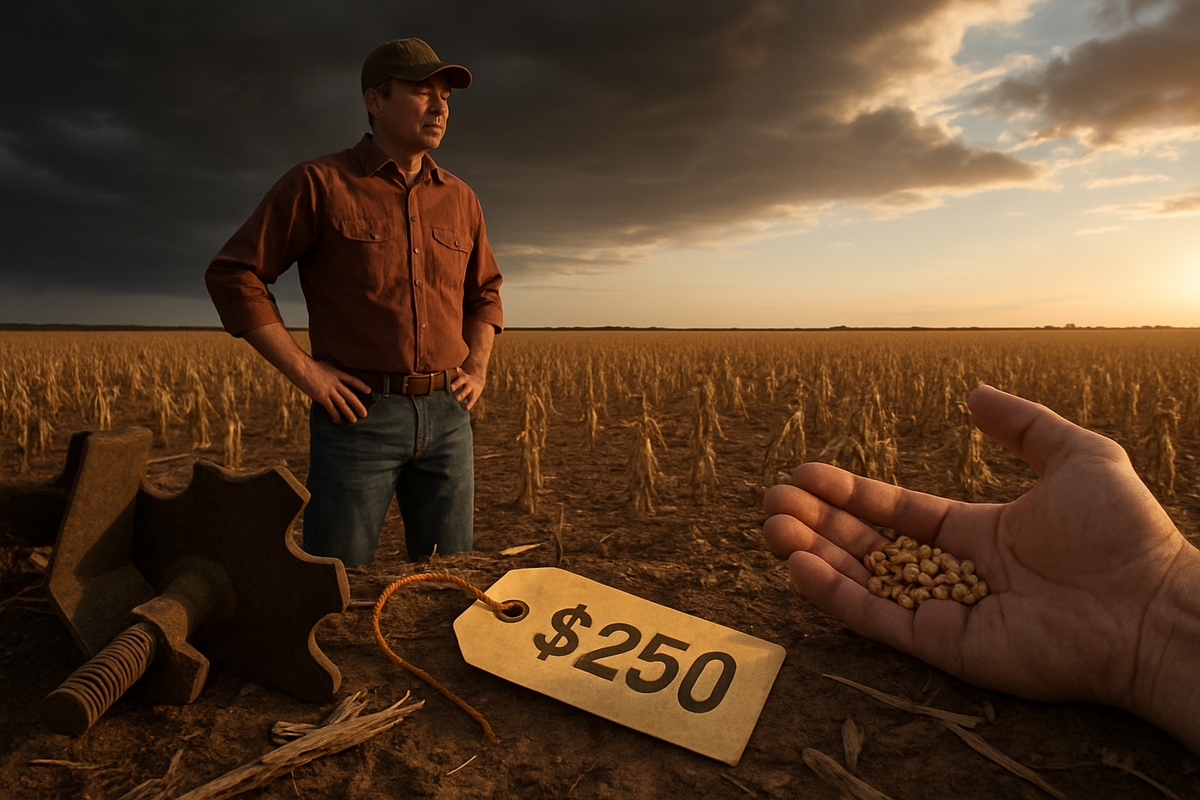
American agriculture is currently navigating a period of intense financial strain, as farmers across the nation face a relentless "cost-price squeeze." This critical challenge, prominently highlighted by the American Farm Bureau Federation (AFBF), stems from a confluence of persistently high input costs for essentials like fuel, fertilizer, and labor, coupled with significantly depressed commodity prices for their harvested outputs. The immediate implications are dire: widespread negative profit margins, escalating financial stress, and a tangible threat to the long-term sustainability and independence of the nation's food production system. As the gap widens between what it costs to grow food and what farmers receive for it, the very foundation of rural economies and America's food supply security is being tested.
The current financial environment is pushing many farming operations to the brink, forcing difficult decisions and, in some cases, leading to the painful reality of closure. This economic pressure not only impacts individual farm families but also sends ripple effects throughout the entire agricultural value chain, from local suppliers to global consumers. The AFBF’s warnings underscore a critical juncture for the industry, demanding attention from policymakers, industry stakeholders, and the wider public, as the viability of American farming hangs in the balance.
A Deep Dive into the Agricultural Economic Crisis
The crisis gripping American agriculture is multifaceted, characterized by a dramatic escalation in the cost of essential farming inputs while the market value of farm products simultaneously declines. This "cost-price squeeze" has intensified over the past few years, reaching a critical point in 2025.
Rising Input Costs: Farmers are contending with historically high expenses across nearly every category:
- Fuel: Diesel prices, crucial for powering farm machinery and transportation, have seen substantial increases. The USDA reported a 34% rise in fuel, lube, and electricity costs in 2022 alone, with diesel prices in June 2022 more than double their pre-2020 levels and up 74% compared to June 2021. The AFBF emphasizes that high energy costs inflate the price of virtually all other goods and services farmers require.
- Fertilizer: This remains a primary concern, with costs driven by global trade disruptions, elevated natural gas prices (a key component in nitrogen fertilizers), and geopolitical instability. While slightly off their 2022 peaks, products like phosphates saw a significant 36% price increase in less than eight months in 2025. Fertilizer accounts for approximately 7% of all farm expenses, making its volatility a major determinant of profitability for row crop operations.
- Labor: Labor costs are at record highs, projected to exceed $53 billion across the agricultural industry in 2025. Programs like the H-2A guestworker program, vital for specialty crops, involve considerable expenses beyond wages, including housing, transportation, and compliance, despite recent Department of Labor efforts to stabilize wage rates.
- Other Essential Inputs: Farmers are also facing surging costs for seeds, chemicals, equipment, repairs, and overheads such as interest, rent, and property taxes. Rising interest rates are making operating loans, increasingly necessary to cover upfront costs, a larger burden on farm budgets.
Plummeting Commodity Prices: Compounding the input cost crisis is the significant decline in commodity prices for major agricultural outputs. Prices for corn, soybeans, wheat, and cotton have fallen substantially from their 2022 highs. Despite strong yields in many regions, the low market prices mean that increased production offers little relief, as it often fails to cover the elevated production costs. A key factor in this decline is decreased export demand, notably from China, which has reportedly shifted its soybean purchases to South American markets, impacting U.S. growers.
Financial Fallout and Industry Reactions: The widening disparity between production costs and market returns has led to widespread financial distress. The AFBF projects substantial losses per acre for many major crops, including over $300 for cotton, $173 for peanuts, $169 for corn, $114 for soybeans, and $154 for rice. This has translated into a dramatic increase in financial instability: Chapter 12 farm bankruptcies surged by 56% year-over-year in the 12 months ending June 30, 2025. Agricultural lenders are reporting weakening liquidity, declining repayment rates, and a higher demand for loans, painting a clear picture of an industry under severe duress. Since the 2017 Census of Agriculture, over 160,000 farms have ceased operations, a stark indicator of the ongoing challenges. The AFBF warns that without intervention, the closure of more family farms will have profound ripple effects on rural communities, local economies, and ultimately, America's long-term food independence.
Market Ripples: Winners and Losers in the Agricultural Squeeze
The severe financial pressures on American farmers are creating significant ripple effects throughout the agricultural supply chain, directly impacting the profitability and strategic decisions of major public companies. While some segments may find temporary advantages, the overall environment of reduced farmer spending and market uncertainty presents substantial headwinds for many.
Deere & Company (NYSE: DE), the global giant in farm machinery, stands as one of the most directly affected by the farmer's financial woes. With farm incomes plummeting and profit margins shrinking, farmers are increasingly postponing or reducing major equipment purchases. Deere anticipates a significant decline, projecting North American agricultural equipment sales to fall by approximately 30% in 2025. This directly impacts the company’s revenue and net income, as evidenced by a substantial drop in Q4 2024 net income. While Deere is strategically investing in precision agriculture and automation technology, aiming to create a "defensive moat" and drive future growth, farmers' ability to invest in such advanced, higher-margin equipment is severely curtailed during periods of low profitability. The accumulation of elevated used equipment inventory further dampens demand for new machinery, exerting downward pressure on Deere's stock valuation.
For Mosaic Company (NYSE: MOS), a leading producer of phosphate and potash fertilizers, the situation is more nuanced but generally challenging. While historically, high crop prices could spur increased fertilizer demand as farmers sought to maximize yields, the current scenario of low crop prices combined with high fertilizer costs for farmers threatens to reduce overall demand or pressure Mosaic's pricing power. Fertilizer prices have been volatile; after soaring in 2022 and decreasing in 2023, some products like phosphate and nitrogen have seen a 15-30% price increase between October 2024 and October 2025. While Mosaic's ability to pass on production costs helps maintain margins, farmer budget constraints remain a significant headwind. The company has also faced increased scrutiny from the U.S. government regarding potential antitrust violations in the agricultural input sector, which could influence future pricing strategies.
Corteva Agriscience (NYSE: CTVA), a major player in seeds and crop protection, also faces direct exposure to farmer spending decisions. When margins are tight, farmers are likely to defer purchases of higher-margin, premium seeds or opt for more economical, potentially generic, crop protection alternatives. While Corteva reported robust demand and pricing gains in its Seed business in the first half of 2025, its Crop Protection net sales decreased due to competitive pricing pressures and broader market dynamics. The company's strategic move to separate its crop protection and seed businesses into two independent entities by the second half of 2026 aims to optimize growth, but the immediate environment of reduced farmer spending could temper these ambitions. Corteva, like Mosaic, is also under government investigation for potential antitrust issues, adding another layer of uncertainty.
Archer-Daniels-Midland Company (NYSE: ADM), a global leader in food processing and commodity trading, experiences a more complex interplay of factors. On one hand, lower commodity prices for farmers can translate into lower raw material costs for ADM, potentially boosting its crushing and processing margins. However, this benefit is often offset by broader market challenges such as reduced global demand, logistical hurdles from trade disputes, or shifts in farmer planting decisions. ADM's Ag Services and Oilseeds (AS&O) segment, a key profit driver, saw its operating profit collapse by 52% year-on-year in Q1 2025, attributed to lower biodiesel margins, reduced vegetable oil demand, and ongoing trade tensions. The company also missed Q2 profit estimates due to lower soy crush margins and waning demand for U.S. crops. ADM has responded with aggressive cost-cutting measures, including layoffs and operational streamlining, to mitigate these pressures. Its stock performance has historically shown a complex relationship with corn prices, often benefiting from low and stable prices, but facing volatility from external shocks.
Beyond these individual companies, the broader industry faces reduced demand for premium inputs, intensifying pressure on input suppliers to lower prices, and increased financial instability for agricultural lenders due to rising farm debt and bankruptcies. Agricultural companies are likely to intensify cost-cutting efforts, re-evaluate product portfolios, and potentially explore mergers and acquisitions to consolidate market share or diversify risk. The current environment also increases the likelihood of government intervention through subsidies or trade policies, adding another layer of complexity to the market dynamics for these major players.
Wider Significance: A Looming Threat to Food Security and Rural Economies
The current cost-price squeeze on American farmers is far more than a cyclical downturn; it is a profound economic challenge interwoven with broader industry trends that threaten the very fabric of the nation's food system and rural communities. This crisis illuminates deep-seated issues ranging from market consolidation to the escalating impacts of climate change, with far-reaching implications for consumers, policymakers, and the global agricultural landscape.
At its core, the squeeze is exacerbated by market consolidation in both upstream and downstream segments of the agricultural industry. A handful of colossal corporations now dominate the supply of essential inputs like seeds, fertilizers, and farm equipment. This lack of competition grants these entities significant leverage to dictate higher prices for farmers. Simultaneously, consolidation among food processors and major retailers means fewer buyers for farmers' products, empowering these large players to depress commodity prices. This long-standing trend accelerates the decline of independent family farms, favoring larger, industrialized agricultural operations that can better absorb the financial shocks. For instance, a 2023 USDA study highlighted that just two companies supplied nearly 72% of corn seeds to U.S. farmers, underscoring the concentrated power at play.
While technology adoption, such as precision farming and advanced machinery, offers the promise of increased efficiency and optimized yields, it comes with a steep price tag. The substantial upfront investment required for these innovations often benefits larger farms that can afford them, further widening the competitive gap and placing smaller operations at a disadvantage. For already struggling farms, the pressure to invest in new technologies to remain competitive can exacerbate debt and operational costs. Adding another layer of complexity are the undeniable impacts of climate change. Extreme weather events—from prolonged droughts and devastating floods to unseasonal temperature swings—are increasing production costs, reducing crop yields, and necessitating greater resource expenditure for irrigation and pest control. These factors directly contribute to lower farmer incomes and can ultimately lead to higher consumer prices for certain commodities, creating a vicious cycle.
The ripple effects of this crisis extend throughout the entire food supply chain. Domestic farmers, burdened by high costs, struggle to compete with international producers who may benefit from lower input expenses or different subsidy structures. Trade policies, particularly tariffs, can boomerang on American agriculture; U.S. tariffs on imported agricultural machinery components can increase domestic farmers' costs, while retaliatory tariffs from other nations (like China's pullback on soybean purchases) can close off crucial export markets and depress commodity prices for U.S. growers. Input suppliers, particularly the consolidated giants, generally maintain a stronger position due to their pricing power, while food processors and retailers can leverage their market dominance to keep purchase prices low from farmers, even as consumer food prices climb due to other supply chain factors. Financial institutions lending to farmers face heightened risks of defaults and bankruptcies, and smaller, regional agricultural businesses are particularly vulnerable as farmers curtail spending. Ultimately, a sustained squeeze threatens to reduce agricultural production capacity, leading to potential food shortages, reduced variety, and increased food insecurity for consumers, as higher farm costs inevitably translate into higher prices at the grocery store.
In response to such severe economic pressures, regulatory and policy implications often come to the forefront. Historically, governments have intervened with direct subsidies, disaster aid, and other financial support programs to bolster farm income, reminiscent of the Agricultural Adjustment Act (AAA) during the Great Depression. However, heavy reliance on such payments raises questions about long-term market sustainability and potential distortions. Growing concerns about market concentration have also spurred antitrust scrutiny, with the USDA and Department of Justice investigating dominant input suppliers to promote competitive supply chains and ensure fair pricing for farmers.
This current crisis is not without historical precedents. The Agricultural Depression of the 1920s and the Great Depression saw farmers grappling with plummeting prices due to post-WWI surpluses, massive debts, and widespread foreclosures, exacerbated by the Dust Bowl. The Farm Crisis of the 1980s forced thousands into bankruptcy amidst high inflation, interest rates, a grain embargo, and collapsing land values, leading to significant rural flight. Even in the late 19th Century, agrarian unrest simmered due to declining prices and the perceived monopolistic practices of railroads and moneylenders. In each instance, a severe cost-price squeeze acted as a catalyst for profound social, economic, and political change in rural America, invariably prompting government intervention and accelerating structural shifts within the agricultural industry. The current challenges, intensified by global trade tensions and the imperative of climate change adaptation, suggest that the wider significance of this squeeze will similarly shape the future of food production and rural economies for years to come.
What Comes Next: Navigating a Shifting Agricultural Landscape
The path forward for American agriculture amidst the persistent cost-price squeeze will be defined by a blend of immediate survival strategies and long-term structural transformations. Farmers, agribusinesses, and policymakers are all grappling with how to adapt to an environment where the traditional models of profitability are under severe strain.
In the short term, farmers are primarily focused on rigorous cost management and strategic operational adjustments. This includes meticulously evaluating every input decision, from seed and chemical purchases to fertilizer applications, prioritizing those with the highest return on investment. Many are opting to repair existing machinery rather than invest in new equipment, deferring significant capital expenditures. Efficient cash flow management, including negotiating payment terms with suppliers and utilizing seasonal credit facilities, is critical. Furthermore, the active use of risk management tools like crop insurance and forward contracts is essential to provide a buffer against market volatility. For many, drawing on financial reserves or taking on additional debt will be a necessary, albeit challenging, step to bridge the gap between declining revenues and elevated production costs.
Looking to the long term, American agriculture is poised for more fundamental shifts. Diversification of income streams is becoming increasingly vital, with farmers exploring new crops, integrating livestock, or even venturing into agritourism to reduce reliance on single commodities. The accelerated adoption of advanced technologies—precision agriculture, automation, and robotics—is expected to continue, aiming to enhance efficiency, reduce labor and input costs, and optimize yields. There's also a growing imperative for a widespread shift towards sustainable and regenerative farming practices, which improve soil health, water retention, and reduce dependency on expensive chemical inputs, offering long-term cost savings and environmental resilience. Crucially, the industry must aggressively pursue market diversification beyond traditional major buyers, given the significant shifts in global trade dynamics.
Strategic pivots for both farmers and agribusinesses will involve leveraging data-driven decision-making using real-time information from satellites, sensors, and farm management software. Enhancing supply chain resilience through flexible infrastructure and diversified logistical routes will be paramount to mitigate disruptions from climate change and geopolitical events. Exploring value-added processing within the U.S. could allow farmers to capture a larger share of the profit margin. On the financial front, restructuring farm debt with specialized agricultural lenders may be necessary to improve working capital and financial stability.
Emerging market opportunities include new export destinations in Africa, Latin America, and Asia, championed by USDA initiatives like the Regional Agricultural Promotion Program (RAPP). Growing consumer demand for sustainably produced, organic, and plant-based foods also presents lucrative niche markets. However, significant challenges loom, including a widening U.S. agricultural trade deficit (projected to hit $49 billion by the end of 2025), a strong U.S. dollar making exports more expensive, persistent trade conflicts and tariffs (especially with China, Canada, and Mexico), intensified global competition from countries like Brazil and Argentina, and escalating logistical disruptions due to climate change (e.g., Panama Canal droughts) and geopolitical instability.
Potential scenarios range from continued financial strain leading to further farm consolidation and increased reliance on government support, to a more optimistic future driven by technology-led transformation, fostering a highly efficient and sustainable sector. Regardless, a lasting reorientation of the global trade landscape for U.S. agriculture seems inevitable, necessitating strategic adaptation and innovation.
Comprehensive Wrap-Up: A Pivotal Moment for American Agriculture
The American agricultural sector is currently at a critical juncture, navigating a severe "cost-price squeeze" that threatens its long-term viability and the nation's food security. The confluence of stubbornly high input costs—from fuel and fertilizer to labor and interest rates—and significantly depressed commodity prices for key outputs has created an unsustainable financial environment for many farmers, leading to negative profit margins, escalating debt, and a concerning rise in farm bankruptcies. This crisis is not an isolated event but rather a symptom of deeper, systemic issues including accelerating market consolidation, the tangible impacts of climate change, and profound shifts in global trade dynamics.
Moving forward, the market will likely continue to experience significant financial strain, leading to further consolidation within the farming sector as smaller or less efficient operations struggle to survive. An increased reliance on government support, particularly through direct payments and disaster aid, is becoming an ever more vital, though often temporary, lifeline for many farms. However, the long-term sustainability of American agriculture hinges on a proactive and multifaceted transformation. This includes a widespread embrace of technological innovation, such as precision agriculture and automation, alongside a strategic diversification of both crops and markets. A pivot towards sustainable and regenerative farming practices is also crucial, offering benefits for both environmental resilience and long-term cost savings.
The lasting impact of this period will likely be a fundamental reorientation of the agricultural landscape. It poses a direct threat to the traditional family farm model, risks exacerbating food insecurity, and will undoubtedly reshape rural economies. Policymakers face the urgent task of crafting responsive and comprehensive solutions, including fair trade policies, robust farm bill funding, and effective antitrust enforcement to ensure competitive markets.
For investors, this complex environment demands careful observation. Key indicators to watch in the coming months include the trajectory of government policy, particularly the details and funding of the next Farm Bill, and any developments in trade policy or antitrust actions against agribusiness giants. The rate of technological adoption by farmers and its impact on efficiency and profitability will be crucial. Monitoring global demand shifts, especially from major historical buyers like China and the growth of emerging markets, alongside the volatile trends in both input and output commodity prices, will provide vital insights. Finally, close attention should be paid to the financial health and strategic pivots of major agricultural companies like Deere & Company (NYSE: DE), Mosaic Company (NYSE: MOS), Corteva Agriscience (NYSE: CTVA), and Archer-Daniels-Midland Company (NYSE: ADM), as their performance will reflect the broader health and direction of the sector.
This content is intended for informational purposes only and is not financial advice







